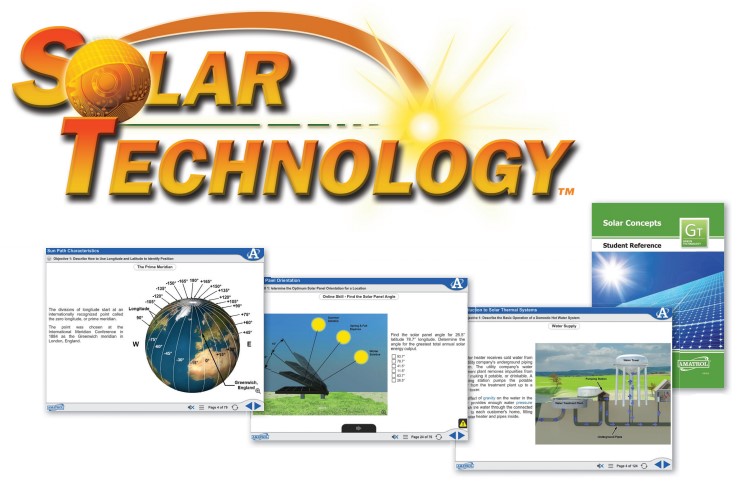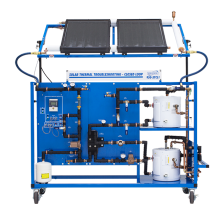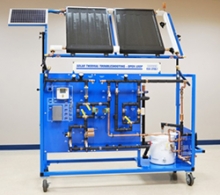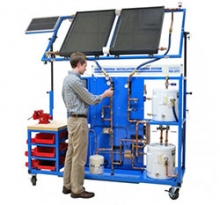Solar Concepts Learning System
Solar energy is being used in a broad range of applications across industry and residences alike. From heating water for home use to creating utility scale electricity – solar energy application is growing, as is the need for solar concepts training. Understanding the basics of how we can harness solar energy is essential for technicians, engineers, installers, designers, builders, and others who want to apply solar technology either professionally or personally.
Amatrol’s Solar Concepts Learning System (950-SC1) introduces learners to a broad range of basic concepts in solar energy and technology. Photovoltaic and thermal solar systems are introduced to students. They learn how to translate location, sun, and technology into practical applications. The Solar Concepts training acts as a foundation for students in solar technology. Solar Concepts includes student curriculum in a highly-interactive, multimedia format.
Solar Concepts Training Features Interactive, Engaging Multimedia
Amatrol’s interactive multimedia provides an engaging, stimulating experience for learners. The Solar Concepts Learning System includes interactive computer-based instruction with both theory and hands-on tutorials consisting of text, digital video, voice, online self-review tests, interactive simulations, color diagrams, and color photos. Amatrol’s strong interactive multimedia includes visual, auditory, and text based learning styles to reinforce each other in well-organized learning segments.
Using Solar Technology to Capture Solar Energy – Location Makes a Difference!
Siting a solar array or understanding how much energy you can capture from an array in a specific location requires a strong understanding of all of the variables therein, which is provided by Amatrol’s Solar Concepts Learning System. The type of application also plays a strong role. With this system, learners study how to site an array with optimum orientation as well as determine the insolation, which varies significantly from place to place.
Optional Solar Instruments Package
The Solar Concepts Learning System teaches learners to use a variety of instruments required to apply solar technology. These virtually developed skills can be reinforced with hands-on application through the optional Solar Instruments Package (95-SIP). The package contains a pyranometer, global positioning system (GPS), inclinometer and compass. Learners will study how to translate their virtual skills to the actual instruments and apply them to solar technology systems. All of these are required to properly orient arrays.
Student Reference Guide
A sample copy of this course’s Student Reference Guide is included with the learning system. Sourced from the multimedia curriculum, the Student Reference Guide takes the entire series’ technical content contained in the learning objectives and combines them into one perfectly-bound book. If you would like to inquire about purchasing additional Student Reference Guides for your program, contact your local Amatrol Representative for more information.
Learning Topics
- Insolation Data
- Array Orientation
- Sun Path
- Solar Time
- Global Positioning
- Peak Sun
- Solar Irradiance
- Space Heating & Cooling
- Passive & Active Water Heating
- Solar Industry
- AC & DC Photovoltaic Systems
- Solar Energy Systems
Key Features
- Interactive, Engaging Multimedia
- Using Solar Technology to Capture Solar Energy
- Optional 95-SIP Solar Instruments Package
Options
Requirements
- Computer: See requirements
More Information
Solar Concepts eLearning
Basic Concepts in Solar Energy & Technology
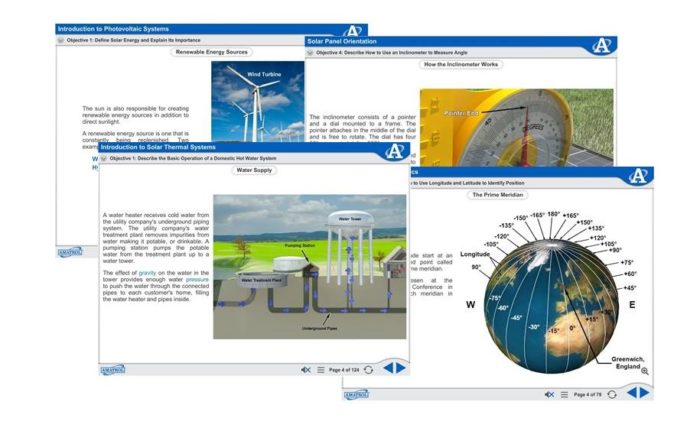 Solar Concepts eLearning introduces a broad range of basic concepts in solar energy and technology, including photovoltaic and thermal solar systems. Learners explore how to translate location, sun, and technology into practical applications. Covers types of solar energy systems, AC & DC photovoltaic systems, solar industry overview, passive and active water heating, space heating and cooling, solar irradiance, peak sun, global positioning, solar time, sun path, array orientation and insolation data.
Solar Concepts eLearning introduces a broad range of basic concepts in solar energy and technology, including photovoltaic and thermal solar systems. Learners explore how to translate location, sun, and technology into practical applications. Covers types of solar energy systems, AC & DC photovoltaic systems, solar industry overview, passive and active water heating, space heating and cooling, solar irradiance, peak sun, global positioning, solar time, sun path, array orientation and insolation data.
What is Solar Energy?
Solar energy is energy generated by the sun’s radiation. The sun’s radiation is created by the intense pressure and heat at its core, which creates a nuclear reaction called fusion. As the fusion process converts hydrogen into helium, it releases enormous amounts of energy in the process. This energy, in the form of radiant light and heat, escapes from the surface of the sun and radiates in all directions. It travels through space and strikes the Earth and other bodies.
Solar energy is the most abundant source of energy on Earth. The amount of solar energy striking the Earth’s atmosphere is approximately 1,366 watts per square meter. However, only a portion of this energy reaches the Earth’s surface because it is diffused, or scattered, as it passes through the atmosphere.
Solar Concepts eLearning Features Engaging, Interactive Multimedia
Amatrol’s extensive, thorough multimedia covers green energy themes such as solar concepts. Interactive screens paired with instructive graphics teach an array of solar concepts topics from sun path characteristics to solar panel orientation. With the optional hardware, learners can then apply this theoretical knowledge to immediate hands-on skills. For example, learners study how to determine solar irradiance and then on their own calculate solar irradiance using air mass for applied practice. This combination of theory and practice ingrains concepts in a learner’s mind and makes more advanced topics easier to comprehend. (References 950-SC1)
Key Features
- Strong Depth and Breadth of Content
- Engaging Interactions
- Stunning 3D Animations
- Text and Audio
- Built for Self-Paced Learning

